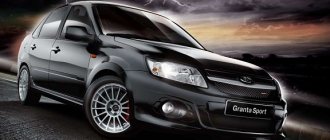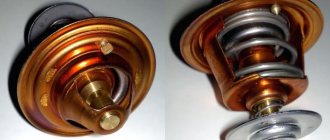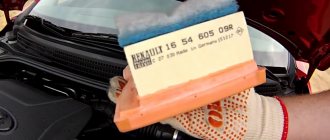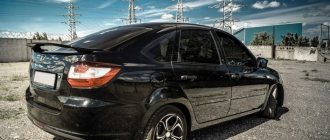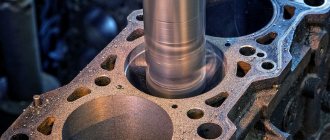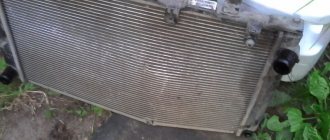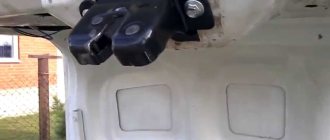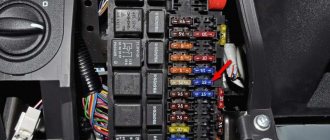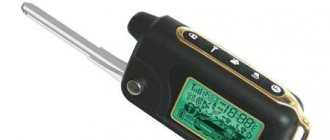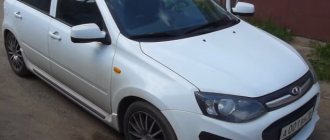Car : Lada Granta. Asked by : Anonymous. Question : Is it necessary to treat the body or bottom of the Lada Granta?
I have long wanted to ask how to treat the underbody of a Granta sedan? Of course, there is no standard processing. So far I don’t see any problems with corrosion, but I wanted to be on the safe side. Or maybe it makes sense to protect some other details? How exactly and with what to process them is what interests me.
Comfort and ease of use
In terms of comfort, each car can compete for the championship.
The seemingly small and not very foldable Kalina differs from the Priora in its spacious interior. It has a more convenient frontal view and a higher seating position. The rear view mirrors are larger, which adds convenience to driving. Otherwise, these cars are equal. By the way, in 2013, Lada Priora became the most stolen car among VAZ cars. Both cars have central locking and an alarm system. But it is worth noting that Kalina car repair shops are visited less often than Prioras. Usually it is not body repair that is required, but repair of the car electronics. There are a lot of electronics in both cars. Fully equipped with front and rear windows, climate control, on-board computer, heated mirrors and heated driver's seat. But even when buying Priora and Kalina in luxury configuration, you will have to take care of wheel arch liners and engine protection.
To summarize, it can be noted that both cars need improvement and many changes. The quality of metal and plastic, safety and reliability in comparison with foreign-made cars still remain at a very low level. For those who prefer calm, measured driving and comfort, the Lada Kalina will be a suitable option. Lower fuel consumption and maneuverability give it some advantage. Priora is preferable for those who love speed and value safety. However, 3 stars for a crash test does not give complete confidence in protection.
Considering that out of 7 criteria, Priora wins in only two, its popularity remains a mystery. Why is Priora, along with Kalina and Granta, the best-selling cars in our country? The thing is that Priora, in the previous modification of the “ten”, has already established itself as a reliable and prestigious car. Over the years we have gotten used to it and grown to love it. But reliability and prestige are relative concepts. “Ten” against the background of classics, “nine” or “eight” seemed truly respectable and reliable. But in our time, cars have become much safer and more spectacular, and the “classics” have sunk into oblivion. In addition, Lada Priora is the only VAZ class B+ car produced.
Need a new car? The choice is between LADA Kalina and LADA Priora? Let's compare both models, find out the shortcomings and decide which one is better.
Anticorrosive treatment. Quality criteria:
As is known, all protective coatings have their own critical thickness, below which long-term protective properties decrease. The physical characteristics of the materials and equipment must ensure that the required thickness of the coating is applied.
The complexity of the body structure with an abundance of hidden cavities requires anti-corrosion materials to have special properties such as penetrating ability and moisture displacement. So, the protective properties of the coating are ensured by applying a film layer of at least a critical thickness.
Penetrating ability is ensured by the penetration of the material into micro-gaps to an effective depth and height in the required quantity. The moisture-displacing ability is ensured by the distribution of the film over the entire area of the wet surface.
All cavities are treated from the outside through small technological openings using spray nozzles in the absence of visual control. Therefore, the equipment and accessories used must guarantee the application of anti-corrosion compounds within the normal film thickness and in the proper volume
Good command of the spraying technique combined with knowledge of the structure of the hidden cavities of the body is a mandatory requirement for a specialist in anti-corrosion treatment; pay attention to this point if you decide to do the anti-corrosion treatment yourself
Make anticorrosive with your own hands. Features of materials:
Professional anti-corrosion compounds must have good thixotropy (the ability to remain in a horizontal position), i.e. After applying the coating to the surface, the film thickness should not decrease below a critical level due to runoff, dripping under the influence of temperature or vibration.
It is a fallacy to say that a material should not change its initial properties over time. According to the laws of physics and chemistry, this is impossible; changes inevitably occur. The best materials are distinguished by the fact that their protective properties change slowly and evenly. Thus, periodic renewal of the protective coating and additional anti-corrosive treatment are necessary.
The car body has hidden cavities of various configurations and sizes, located in different places. Accordingly, these cavities have different microclimates - humidity, temperature, electrolyte concentration. Some areas of the body, due to their aggressive microclimate, are more susceptible to corrosion. Such areas are called critical. Examples of such areas are cavities with an abundance of microgaps and welds. The lower they are located and the closer to the engine compartment, the higher the corrosion rate.
This happens for the following reasons:
- in microgaps the electrolyte lasts longer than in open areas;
- water from the road constantly gets onto the lower part of the body;
- areas near the engine compartment become hot.
Another example is box sections designed without regard to corrosion resistance requirements. Such sections retain water and are exposed to high humidity for a long time, and in winter they are subject to the forces of freezing water increasing in volume.
Thus, effective protection is ensured by paying special attention to critical areas. The mere presence of anti-corrosion material in hidden cavities is not enough for a high rating of vehicle treatment
In order to evaluate the quality of processing, it is necessary to ensure that the material is present in critical areas, and that the film thickness and volume of the composition will provide reliable protection for the longest possible period of operation.
5) Drying
Each vehicle must be dried before anti-corrosion materials are applied. After washing with a high-pressure apparatus, the car dries unevenly, water may remain in the cavities, while the underbody will already be dry. Cavity materials can be applied to wet surfaces, but not to “puddles” of water.
Drying the surface with an air gun is not recommended. Drying should be done with intense air movement or with the help of natural ventilation outside in warm weather if you are going to make anti-corrosive paint with your own hands without a specialized room.
If, during the evaporation of a substance, the evaporated molecules are not removed from the surface of the liquid, a moment comes when the number of molecules that have passed from the liquid to the gaseous state is equal to the number of molecules that make the reverse transition from gas to liquid. They say that the point of saturation has arrived and under these conditions no further evaporation occurs.
The moment at which saturation occurs depends on several factors, for example, the type of liquid, temperature, etc. In the case of water and white spirit, this time is very short (on the order of a few milliseconds).
When the moment of saturation arrives, evaporation does not occur and the liquid remains where it was. The only way to cause evaporation again is to remove the evaporated molecules from the surface of the liquid. The easiest way to do this is to ensure the movement of dry air along the surface.
An increase in air temperature leads to an increase in the number of molecules passing from liquid to gas, but the moment of saturation will still occur if the evaporated molecules do not move away from the surface. At the moment of saturation at elevated temperatures, the number of molecules passing from the liquid to the gaseous state and back will still be equal, but their total number will be greater, the higher the temperature.
Thus, increasing the temperature and intensively blowing dry air onto the surface increases the drying efficiency.
Lada Kalina or Lada Granta
A large group of engineers worked to create the design for both cars. Each looks modern and looks like a foreign car. Grant's design was created from the very beginning by analogy with Kalina. The engines on both cars are practically no different. Both have improved suspension. The gearbox is also identical.
The metal body of the Grant is very thin. Manufacturers explained this by using a completely different type of metal. But it can bend easily, since it is made of thin metal. They also decided to save money on the plastic bumper. On the new Grant, at first the doors lock and open well, but after some time you will have to make an effort to do this procedure. Kalina has no such defects.
There are also differences in the seats. Granta's are cheap and cannot boast of comfort. Kalina has anatomical seats that follow the shape of the human body; they are more comfortable when sitting. The interior of each car is wide. When driving on gravel, the Granta cannot be called quiet. When a stone hits the body, the sound will be clearly audible. In terms of sound insulation, Kalina, of course, is also not ideal, but it is still much quieter.
To keep the cost of the car lower, Granta was supplied with low-quality plastic. It is very easy to scratch and looks cheap. This is not the case in Kalina. The Granta can reach greater speeds thanks to its aerodynamic properties. However, the difference with Kalina is small. Fuel consumption also does not differ significantly. If you look at the little things, the Granta does not have limit switches on the doors and headlight hydraulic adjustment.
If we consider the Grant, it does not look like Russian cars, but the side doors unite it with the Kalina. In terms of luggage racks, Kalina is inferior to Granta. Due to the increased body length, the Granta's trunk is large, but it looks unaesthetic and closes loudly. However, Granta wins with its dashboard, which does not make sounds, which cannot be said about Kalina. The Granta has one more advantage - a short steering rack. But there was no room left for an ashtray.
The Grant has a Kalina engine, but it has some advantages. With the same number of valves, the engine power of the Grant is greater than that of the Kalina. This is explained by the installed lightweight connecting rod and piston group. In general, Kalina moves slower than Granta. The Granta engine runs without any noise, but Kalina has better plastic casing material.
If we compare the safety of cars, we should note the airbags in Grant, which are not present in Kalina. Given the budget class, this is a big plus for the Grant. Even if we briefly evaluate these two cars, we can say that the Granta is no worse than the Kalina, although it is made on its basis. When comparing the parameters, it can be called even the best. Kalina is more expensive than Grants by about 30 thousand rubles. Grant can be considered an alternative to Kalina.
Granta will be produced, like Kalina, in a hatchback body. If you evaluate from this point of view, Grant looks youthful. Each of the cars is inferior in some ways, but good in some ways and even superior to the other, but at an insignificant level. If we talk about the price category, then it is better to take the Lada Granta.
Inexpensive crossover: Skoda Yeti
Models from many brands are equally vying for the title of king of corrosion in this price category. Among them are Lifan X60, Renault Duster, Geely Emgrand X7, Mitsubishi ASX and even the best-selling crossover of recent years, Hyundai Creta.
Yeti became an anti-leader due to the risk of rapid corrosion - many claims were received during the warranty period.
Main causes of corrosion
Lada Granta is a new AvtoVAZ car based on the Lada Kalina platform. The design of the car has been carefully worked out, the number of parts in different components of the car has been reduced, and the air intakes in the front bumper have been enlarged. The good quality, convenience and reliability of the car allow it to be used even in difficult weather conditions.
The condition of highways and the various preparations with which road services treat them cause corrosion of the car body in a short period of time, and the appearance of the car is also lost. Main causes of corrosion:
- improper care;
- poor quality factory coating;
- complex car design;
- operation in difficult conditions.
To increase the service life of cars, it is necessary to protect the body from adverse weather conditions, and it is not necessary to wait for obvious signs of corrosion to appear, but to do the coating earlier.
What do official representatives of the domestic auto giant say?
At the factory, the metal body panels of the Lada Grant are treated with a zinc layer. The low cost of the model we are considering does not allow such coverage over the entire body area. The most vulnerable areas are subject to protection. This applies to:
- door panels;
- hind wings;
- niches for stern wheels;
- luggage compartment covers;
- protective body screen;
- bottoms;
- rear fender gutters.
This statement gives an understanding of the issue regarding the galvanization of body components of the Lada Grant. In this regard, discussions around the products of the domestic auto industry are heating up with serious force. While fans and owners continue to argue, AvtoVAZ is improving its car production strategy, the list of main priorities of which includes galvanizing body components.
Factory conditions require the application of the following types of coatings:
- thermal galvanizing, which is the most reliable means of processing;
- galvanization, which involves obtaining a zinc layer on body panels formed by an appropriate solution under the influence of an electric current;
- a primer coating that involves the preliminary application of salts containing impurities of manganese, zinc and iron to the metal surface.
Myth 3: Only exposed areas of the body rust, which cannot be protected with anticorrosive.
It's not like that at all
Please note that many cars rust along the lower edges of external surfaces and elements. The edges of hoods, doors, trunk lids, the edges of roof panels, the lower edges of fixed rear fenders - these are the first areas to be attacked by corrosion.
Why? It's all about condensed moisture, which inevitably forms in the off-season. During night frosts, the body metal cools to low temperatures and dew falls on it. And not only from the outside, but also from the inside - after all, the air and the moisture contained in it penetrates into all unsealed cavities. And if the dew dries on the outer panels, it does not on the inner panels. Droplets of moisture flow down to the lower edges and collect there, gradually penetrating to the steel through a thin layer of soil. As a result, rust - hydrated iron oxide - breaks out from under the paint. Therefore, first of all, it is necessary to protect the hidden cavities of the body and the joints of metal sheets with anticorrosive agents!
Galvanization: has the body been processed at the proper level?
Today, at the Togliatti plant, the processing of the body and its metal parts involves a standard layer of galvanization. True, not the entire area of the car is subjected to this process, but only the most vulnerable areas of the body, such as the bottom, etc. First of all, these areas are located close to the road surface, thereby being damaged quite often: chips, scratches and damage to the integrity of the surface paintwork Such places of the body are a common phenomenon.
Lada Granta galvanized body
On the one hand, a layer of galvanization, of course, cannot completely protect the metal from corrosion. On the other hand, if it were not there, the elements would begin to rust in short periods of time, after some minor accident or the car falling off the jack.
Galvanizing the Lada Granta body
There is a lot of controversy regarding galvanizing. In particular, the question concerns the following: is the body of the Lada Granta sufficiently galvanized, if we keep in mind the percentage ratio. Here is what I would like to say about this:
- Lada Granta is considered a budget car, which automatically excludes full processing;
- It is precisely because the Granta is a budget car that it has fewer body elements designed to work in harsh conditions.
On the other hand, all “vitally” important body elements of the car are, of course, coated at the factory with a layer of galvanization. This happens in the press shop, where zinc is applied to the steel sheet on both sides.
Is it worth carrying out additional anti-corrosion treatment on the Lada Granta? Car owners often ask on forums. The manufacturer does not advise doing this, hinting that he has foreseen everything himself. On the other hand, no matter what guarantee against corrosion AvtoVAZ gives for the first 6 years of car operation, we were not born yesterday, and we understand that the manufacturer’s guarantee is one thing, but the real situation is completely different.
Here are the areas of the domestic car that are most at risk:
- Rear wheel wells and fenders;
- Trunk sides;
- Bottom;
- Door pillars and trim;
- Protective components, etc.
Some car owners claim that some Grants do not have galvanization at all, which explains the low cost of the car. Is it really? AvtoVAZ categorically denies this information, claiming the opposite. Yes, galvanizing does not occur in full, but the strategy of protecting the most important areas of the body is carried out without fail.
In general, quite a lot of myths about domestic car models have been appearing lately. Some people, supposedly cool specialists, come to various topics and start spouting all sorts of nonsense that AvtoVAZ products will soon crumble before our eyes. It is noteworthy that most of the “false experts” are personally unfamiliar with modern versions, but judge products based on old models from the 90s.
The modern corrosion resistance of VAZ models, even the most budget ones, has improved significantly. Modern paint booths, “smart” robots, universal stamping shops with the appropriate equipment - all this is available and working at AvtoVAZ today. And the result does not take long to wait: body gaps have decreased, parts have been fitted perfectly. In addition, all surfaces of the body undergo appropriate treatment, since the entire body is immersed in a bath of primer. If earlier it was difficult to imagine, today no one doubts the power of a robot that can easily lift a heavy body as a whole and dip it properly into the composition.
What is the Lada Granta body made of?
It is also worth noting that today any car produced by AvtoVAZ undergoes rigorous testing. For example, it is kept in a saline solution for more than 2 days, then scratched to the metal. So what: corrosion only shows up slightly, but the Niva’s body, painted using old technologies and not galvanized, also subject to a similar test, is literally eaten away by rust.
The issue with body rigidity has also been successfully resolved today. The same Lada Granta, despite its budget, is equipped with a reinforcing “bulkhead” in the rear. This applies to the sedan, but the liftback, which will be described in detail below, has been worked out even more carefully in terms of body rigidity. The fact is that 5-door modifications do not provide rear reinforcement, which is why maximum rigidity is given in this case. Compared to the “chisel”, the body rigidity of the Lada Granta (hatchback) is increased by 2 times!
Lada Granta body number
By the way, for those who are interested, the body number of the Lada Grant can be found in the engine compartment right on the edge near the shock absorber strut on the front passenger side.
DIY repair
VAZ body repair
As you can see, body work includes a large range of operations. The table does not show all types of work, but only the most basic ones.
Experts recommend: before you start repairing yourself, you need to assess the technical condition of the body. This will give you the opportunity to decide on several points:
- What specific work needs to be done;
- Is it advisable to carry out repairs or is it better to replace the body part;
- Is it worth taking on the work on your own or is the condition of the part so serious that it is better to trust qualified specialists?
A visual inspection involves the following actions:
- Determining the body for dents;
- Check for chips and scratches;
- Visual detection of paintwork peeling;
- Check for the presence of corrosion spots (wheel arches, underbody and sills are inspected in detail).
On VAZ models, whatever one may say, the quality of the metal leaves much to be desired. This mainly concerns the insufficient level of anti-corrosion treatment, which causes the onset and development of corrosion over time.
Body geometry
Checking the geometry of the body is the most important stage of body work. This event is especially relevant if the car has been in an accident. Only here you will have to carry out the check correctly, however, at a special stand, which is available at the service station. Although, if you know the geometric dimensions of certain car models, you can measure the main distances with a regular ruler in your garage.
Capital or partial
Body repair of Lada Granta
Next, you need to decide on a budget. If finances are tight, then you can choose not to carry out major repairs, but only partially.
So, a major overhaul or repair, although it seems like a more complex and extensive operation, gives a better effect, guaranteeing an increase in various operational characteristics of the car (if everything is done correctly, of course).
VAZ body polishing
It is advisable to completely disassemble the car during the inspection. It is necessary to remove all attached parts and certain components in order to detect hidden defects and perform the work more efficiently.
Used VAZ models, especially sedans, mainly have the following damage:
- Left side of the underbody, driver's side. This zone is subject to particularly intense corrosion on Togliatti-assembled machines;
- Luggage compartment niche. Here, too, it would be appropriate to conduct a thorough check of the metal elements of the body for defects and corrosion;
- Spars, especially rear ones;
- Door sills with their amplifiers;
- The wheel arches, again, on some models, such as the VAZ 21099, are larger at the rear.
As a rule, not a single RC is complete without welding. Rust eats through the parts, and you have to install patches that need to be skillfully welded. In special cases, parts are completely replaced. And again, you can’t do without welding work here.
Watch a video about how body repair and painting is carried out
“Lada Kalina II” or “Lada Priora I”: which is better and does it make sense to buy
At first glance, the question sounds like “do you want black or green tea?” On the second one, actually, too. Before the arrival of foreign engineers and managers, VAZ riveted surprisingly identical cars, even if they formally belonged to different classes.
On the secondary market, the second Kalina and the first generation restyled Priora cost almost the same - 314 and 312 thousand rubles, respectively. Offers for them are also almost at the same level - 140-155, but Priora is most often bought and sold. In May, it was checked 22,730 times through avtocod.ru, placing it in second place among all models. “Kalina” ended up in 16th place with 12,997 checks. What is better to buy on the secondary market - Priora or Kalina, let's figure it out.
Premium: Mercedes-Benz (2000–2005 model years)
Almost all modern premium models are hot-dip galvanized and can withstand 8–12 years without problems. Mercedes ended up on the red list because of the cars from the beginning of the century: the most popular bodies - C-, E- and S-class - quickly rusted. With the release of new generations, the problem disappeared.
Lada Priora
The next domestic model produced at the Volzhsky Automobile Plant is the Lada Priora. Today it is produced in 4 body variations. The line of models also includes the Priora Coupe - which, however, has not yet gained any popularity among Russians.
Lada Priora
An important parameter of the Priora body, again, is the LCD/c value. It is noteworthy that for the Priora this figure is 12,000 Nm/deg in the sedan version. In other variations, except for the coupe, it is a row lower.
Despite this, there are general indicators for all 3 models, implying body dimensions. Thus, all body types (except coupe) have the same wheelbase, ground clearance and width. As for the length, let us recall that the sedan’s figures are 4350 mm, the hatchback’s are 4,210 mm, and the station wagon’s are 4,340 mm. The heights of the bodies are also different: the sedan is 1420 mm, the hatchback is 1435 mm, and the station wagon is 1508 mm.
Initially, the weak areas of Priora bodies were considered to be the roof, hood and trunk. It is for this reason that experts insist on the mandatory treatment of all internal surfaces of problem areas by the car owner himself with an anticorrosive agent.
Priora body protection against corrosion is provided for 6 years. In practice, this period is determined by: zinc coating of the sills, bottom and arches, as well as the use of low-alloy steel.
Dimensions of Priora
Indeed, practical experience has proven that the Priora body is incredibly resistant to corrosion. If problems start, the first ones at risk are the bumpers, then bubbles form on the paintwork in the winter, and the paint peels off.
The 12 thousand Nm/deg indicator on the Priora sedan is not a large value. Even the VAZ-21106, not to mention foreign cars, has a higher figure. Thus, Priora owners who prefer active driving would do well to strengthen the car’s frame. In particular, strengthening should involve the installation of strut struts and modernization of the SPU on the rear axle.
Video story about Grant's rusty sedan
Interesting and useful article, I didn’t know that you didn’t have to treat the underbody of a Lada Granta car, otherwise when you come to the service center, as always, they want to scam you, rip you off for unnecessary work
If you treat it for prevention, then, from my own experience, I also recommend bitumen. I have been treating the bottom using the passive method for several years now; bitumen is an excellent anti-corrosion mastic. For more serious processing, in my opinion, Movil is also well suited.
I think that the bottom needs to be treated, since now in autumn there is water, mud, and a lot of potholes on the roads. It will be better if processed. By the way, I support Oleg regarding Movil.
The serviceman, of course, is driving... 1 year grant and holes? An oak tree fell off or something, a tin can will not rot in 1 year. I understand, I would say 5-6 years, even the crappy metal will last that long. And yes, VAZ’s crafts are shocking, he himself has two grants. One is already 6 years old, all the joints on the bottom are corroded!
Yes, the author of the video is stupid and even very stupid and the car is not 1.5 years old, as Zoschyain says, it was used only in the summer and is in the garage, they would only hate Russia, I have a 2012 Grania in use all year round, mileage 180,000 only in 2022 they changed the racks all because The one left leaking bottom has not been treated and everything is intact without rust, at the junction of the stabilizer to the body and to the levers, due to the work of the rubber bands, it has worn out but has not rusted, stop scolding AvtoVAZ for what you did, don’t like it, buy a foreign car and roll and don’t get under AvtoVAZ
Source
Work technology, materials used
Anti-corrosion treatment of Lada Granta is carried out in several stages.
Sequence of work:
- washing;
- drying;
- visual inspection;
- removing rust;
- processing of internal cavities;
- coating of external surfaces of the body;
- assembly.
External processing is carried out on an overpass or from an inspection hole
To carry out the work you need to prepare:
- anticorrosive black "Tektil" - 5 kg;
- aerosol cans of Tektil ML - 4 pcs.;
- brushes of different widths and hardness;
- latex gloves;
- plastic tube;
- metalworking tools;
- solvent.
To work, you will need an inspection pit or overpass with a lift.
Self-processing - is it possible?
Since high-quality car processing in specialized services will cost a pretty penny, sophisticated owners, after studying the issues of how to process a Lada Granta video, began to implement the acquired knowledge.
First of all, if you decide to carry out the processing yourself, you must understand that without certain skills and special equipment, the quality of the result will be poor.
You can achieve adequate results only by strictly following the instructions. Thus, do-it-yourself anticorrosive Lada Granta is a matter that requires collecting information, without which it is impossible to take into account all the features and subtleties of the process.
Use of Movil aerosol
Anti-corrosion composition in cans has its advantages:
- due to the small size of the bottle, access to almost any body surface is provided; for treating hard-to-reach places, the bottle is equipped with a special nozzle-tube;
- to work with the spray you do not need special equipment and a compressor; the work can be done in almost any conditions;
- As a rule, such a product does not have such a strong odor;
- The car can be used within a few hours after applying the anticorrosive agent.
But aerosols are also not without their disadvantages, and the disadvantages are quite significant:
- The composition is not used as economically, resulting in a less even layer;
- It takes longer to process large areas of the body;
- chemical spray is more expensive.
Using a spray bottle is convenient for treating small surfaces, for example, a welding seam; before use, the bottle with aerosol liquid must be shaken several times.
Types of metal corrosion
Rust formations can be of different types, and today there are about 20 varieties of such “damage”. Let's look at the main types of corrosion:
- Gas - destroys the muffler, exhaust pipe, as well as the chamfers of the exhaust valve plates located in the combustion chamber.
- In non-electrolytes. Most often, fuel and oil systems are subject to such corrosion.
- In electrolytes. Rust forms as a result of stagnant moisture.
- Under tension. Most often, this corrosion appears in areas subject to high stress.
- Contact - formed in places where metals of different potentials come into contact.
- Slit. This type of corrosion occurs as a result of stagnation and contact of moisture with oxygen in narrow gaps, crevices and cracks in the paintwork.
- Atmospheric - appears during improper transportation, operation or storage of the vehicle.
- Biocorrosion is rust that appears under the influence of microorganisms and their metabolic products.
- Structural. Formed after welding.
- Mechanical. This type of corrosion is the most common, as it is caused by impacts from pebbles or crushed stone.
Corrosion can also form if you often drive through tall grass or sand, or leave your car outdoors in winter or, conversely, in an unventilated garage.
Available configurations
You can find three variants of each vehicle (sedan, hatchback and station wagon). True, new Kalina sedans are no longer produced, but there are quite a lot of them on the secondary market, so there shouldn’t be any problems here.
Kalina:
- standard. Here you will see only everything you need, there are no frills. Among the main elements, it is worth highlighting the presence of front electric windows, original bumpers, an anti-theft alarm and a remote-controlled lock. This option comes with a 1.6-liter power unit producing 81 horsepower. Price – about 280 thousand rubles;
- norm. Here you can already find anti-lock braking and climate control systems, as well as power steering and a number of small parts, such as a mirror in the passenger visor. 1.4 liter engine (89 horses). Cost – from 325 thousand. There is also an external difference - the wheels have increased to 14 inches;
- Luxury For an amount of just over 350 thousand you will receive airbags for the driver and front seat passenger, velor interior, headrests for rear passengers, electric drive and heated side mirrors. The car will also delight its owners with a number of useful functions, such as heated seats, electric lifts for all windows, fog lights, etc. The model has a 1.6-liter power unit with a capacity of 98 horsepower.
Below is a video with a test drive of the Lada Kalina:
Priora:
- standard. Here the airbag comes as standard. In addition, there is also the option of a remote trunk lock, power windows at the front, and an alarm system. Not too much, but better than Kalina's. True, the eight-valve 1.6-liter engine with 90 horses does not inspire much admiration. Price – from 320 thousand;
- norm. It will cost from 325 thousand. Comes with a 16-valve engine (volume 1.6 liters, power - 98 horses). It is distinguished by the presence of a built-in anti-lock braking system, velor interior, power steering, electric drive and seat heating option. There are as many as 7 modifications of this configuration. The most expensive model has standard navigation, a good audio system and electric power steering;
- lux. Here you can see an anti-lock braking system, parking sensors, climate control, heated seats, electric windows, etc. The cost reaches almost 410 thousand rubles. In principle, the equipment is quite good, but the price is quite high.
If you choose which is better: Kalina or Priora, then the choice definitely falls on the first option. At the same cost, the configuration of this car is somewhat ahead of its main competitor.
Fuel consumption of compared cars
In conditions of endless growth in prices for fuel resources, such an indicator as consumption worries the future owner. Which is better in this regard and more economical than LADA Priora or LADA Kalina? If we do not touch upon cars that have been chip-tuned, as a result of which the factory balance between the level of fuel consumption and dynamic performance was deliberately disrupted, then in the standard version both models have approximately identical “appetites”. Priora in the city cycle will “ask” for about 7-9.6 liters, and on the highway – 6-7 liters.
Its rival in a pair, Kalina station wagon or Priora station wagon, “eats” 7-9 liters and 6-6.8 liters, respectively, in similar modes. All data is based on a 100-kilometer run. The figures are very conditional, since it is no secret that the level of fuel consumption can change dramatically with different driving styles. Calm drivers can easily meet the manufacturer’s stated figures, while road “aggressors”, for whom every overtaking is regarded as a personal challenge, can easily almost double their consumption. Let's continue the comparison.
Cost and equipment
The equipment in standard cars is approximately the same, but the Granta has a slightly smaller choice of equipment (everything is limited to one airbag, EBD, ABS and BAS systems, DRLs, as well as tinting).
The Priora is also equipped with an eyeglass case, an on-board computer, an electronic power steering, as well as handles to match the body color. Moreover, the price here is almost identical - about 390 thousand rubles.
Such a difference is quite justified, since the Granta will have such useful options as multimedia with a seven-inch touch screen, parking sensors, a passenger airbag, a light and rain sensor, Bluetooth, etc.
